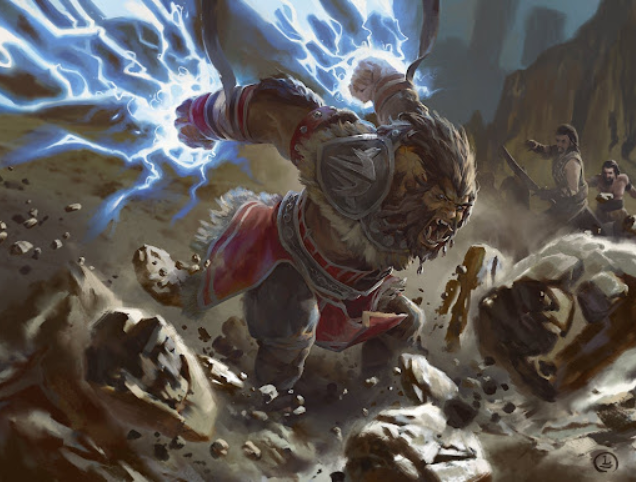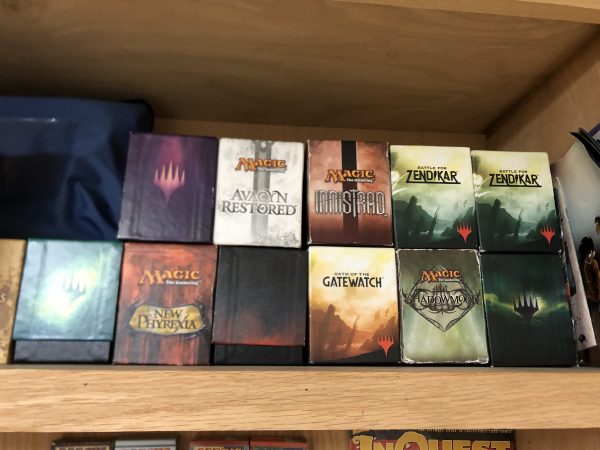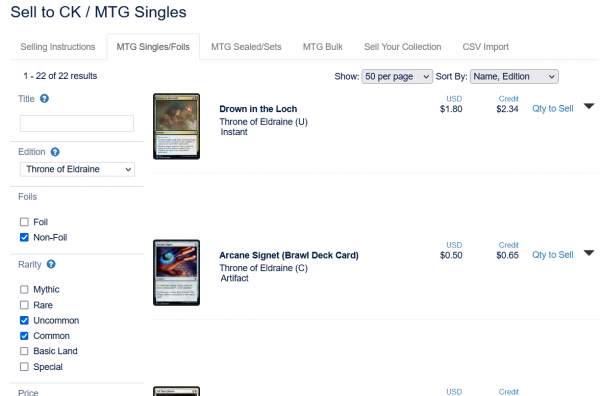Are you a Quiet Speculation member?
If not, now is a perfect time to join up! Our powerful tools, breaking-news analysis, and exclusive Discord channel will make sure you stay up to date and ahead of the curve.
I found myself with excess downtime this past weekend—a true rarity for someone with two young children. I caught up on some reading, practiced my chess (I seem to be stuck in a rating range now and it’s requiring tremendous concentration to try and break out of it), and pondered one of my favorite time-killing activities of all: buylisting.
How can a simple buylist eat up so much time? Well, it’s not the primary cards I’m selling—those that are worth real dollars—that take up the time. My collection isn’t that large these days, and the value is highly concentrated in my Old School collection. Instead, the therapeutic activity I like to implement while buylisting is the process of picking my bulk for nickels and dimes.
Most of my buylists contain a few hero cards alongside a small pile (5-50) of $0.05 commons and uncommons. I figure if I’m paying for shipping already, and I have the time, why not? If over time I could buylist the majority of my bulk for a nickel, that would equate to $50/1000, far in excess of the typical $2 or $3/1000 you’d get from “bulking out” your collection to a vendor.
This week I’ll share the process I follow, in case there are some tidbits of useful tricks that will help you make your buylist process that much easier.
Prework: Organization & Sorting
When I started playing Magic many years ago, my collection was relatively small and it was inconsequential whether my collection was organized or not. As time went on, new sets came out, and I started having a difficult time tracking what I owned. I suspect this is even more a challenge for newer players as the number of new products being released has dramatically increased between 1997 (when I started) and 2021.
Over time, I came up with a pseudo-natural process for organizing. For a time, most of the new product I obtained was via drafts and the occasional bundle, so it was easy to at least keep my cards separated by set. One of the advantages of purchasing bundles is the lovely set-themed box you receive along with the packs. Whenever I purchased one, I’d organize all cards from that set within the box. If you’re in the habit of purchasing booster boxes or bundles, you could follow a similar practice. This eliminates confusion and the need to label the box since the box itself is already labeled with the set for you!
Set sorting is a huge step in organizing one’s collection, but it’s not the final step. As I open new packs/product and my bulk accumulates, I make sure to keep cards sorted by color in addition to set. I find this natural delineation is the perfect balance between time/effort and utility.
You could go one step further and sort by commons and uncommons. You could go another step and sort alphabetically. The former is probably worthwhile (I have done this before), but the latter is a major time commitment. Unless you’re extremely particular and you plan on picking through bulk on a regular basis (i.e. weekly or more often), the color/set sorting is generally sufficient to implement my buylist strategy.
Finding the Needles in the Haystack
Once your cards are sorted in this manner, the process of finding your nickels and dimes becomes more manageable. To proceed, navigate to your prospective buyer’s buylist page and filter to a single set, common and uncommon rarity, and non-foil. Below is an image of how to perform this filtering on Card Kingdom’s site, my usual go-to store.
Here you can see I’ve filtered down to Throne of Eldraine non-foil commons and uncommons. There are currently only 22 on their buylist, and some won’t apply because they are particular to the Brawl decks…since I didn’t purchase Brawl Decks, I know I don’t have any of those cards.
From here, you can scroll down and identify a couple of cards of the same color on buylist. With those couple in mind, grab the corresponding bulk cards you own and start picking. It doesn’t take too long (unless you have 1000’s of bulk cards of each color…I do not).
After you finish looking through Throne of Eldraine, you can move on to other sets in your collection. One by one, you can cycle through and find any bulk you may have that can be buylisted for at least a nickel.
This may sound like a daunting process at first, but there are two factors with this approach that work in your favor over time. First, many of the obvious picks from your bulk will be easiest to remember and find—you only need to dig through your bulk and find Drown in the Lochs once. After that, you know you’ve already picked this card and you can skip it. The same likely goes for most of the top few cards in the set.
It’s highly infrequent for a bulk card to go from being worth three cents to worth a dollar, especially from newer sets. Therefore when I follow this picking process, I often skip over the top few cards if I’ve picked the set at least once already. There’s no point in going back over the same ground.
In tandem with this, the second factor is that, over time, you’ll begin to remember the cards you picked. This makes browsing one set to the next a faster and faster process. Card Kingdom is constantly cycling through different $0.05 cards on their buylist, so it’s always worth checking. But you don’t have to check for cards you remember already picking. The more you practice this process, the faster it becomes!
The Wildcard Bin
I don’t submit new buylists all that often nowadays. A chunk of time may pass in between, where I may still be acquiring new bulk or finding the occasional nickel and dime while sorting through cards. When that happens, I have a special box where I place any cards I anticipate will be worth shipping for non-bulk at a given time in the future.
Not just anything goes into this box, mind you. This is for stalwart commons like Unsummon, Mana Leak, and Faithless Looting. These are the kinds of cards you know are playable in one format or another, and should be worth something more than bulk. This process is particularly helpful when picking out cards that don’t go in one of my pre-organized boxes. After all, I don’t have a box set aside for every single set and I don’t have enough bulk in most sets to justify following the process I outlined above.
This catch-all “Wildcard Bin” is where I store those cards I come across that I think should be above bulk. Then after I browse through some sets with my method above, I pull out some of these individual cards and run a search for them on the buylist I’m shopping. Inevitably, a few show up on the list and I’m able to ship them out.
I’ll admit this portion of the process can be a little more time consuming than the others, but it’s the best way I’ve come up with to keep a watch on key cards that could be worth something, but don’t fit into one of my pre-organized sets. The procedure is effective, however, and I find the process calming in its own right. Perhaps if I found the task obnoxious or tedious, I wouldn’t bother with this step—sometimes I am in a rush and this is the step I will skip (after all, the same cards have the same likelihood of being relevant the next time). But with a mission of shipping out as many cards for a nickel as possible, this is a necessary step because I’m not going to set sort my entire bulk collection when many sets would have just a couple cards in their respective pile.
Wrapping It Up
Since I find the process of picking bulk relaxing—even rewarding at times—you can see why I spend so much time optimizing the process. For full transparency, last weekend I spent about 60-90 minutes going through an extensive combing of my bulk. In that time, I probably found about $6.50 worth of cards to ship to Card Kingdom.
On a dollar per hour basis, this is horrendous at best. Surely, there are more productive activities one could do with their time. The key here is that I enjoyed the activity. If the task looks daunting and unenjoyable to you, by all means skip it and move on to bigger and better things. For me, it feels like I’m being paid to a) relax, b) organize my collection, and c) cull back my collection to streamline it. The concept of exchanging 70 cards for one I’ll actually use is something I appreciate. As a minimalist and one who likes to consolidate, this is a big motivator.
If you’re like me and also appreciate trading a bunch of nickels for something of actual value and use, I’d try organizing your collection in the minimal way I proposed above. It works fairly well, and also doesn’t demand excessive amounts of time alphabetizing. You never know what you’ll find. This last time around, my big find was an Impact Tremors, which I had no idea was worth as much as it is. That alone made the activity worth it.






